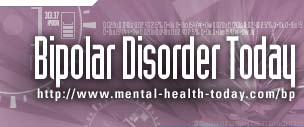 |
|
 |
|
|
||||
|
| Bipolar
Disorder Today Menu |
||||
|
BP Bookstore Dr.'s Archive DSM IV Diagnosis BP Research Articles BP Bulletin Board Family BP Board Personal Stories Consumers Speak Out BP Self Care Clinicians BP Resources BP FAQs Free Medication About Contact Links/Webrings
|
DSM IV Criteria
The essential features of Cyclothymic Disorder is a chronic, fluctuating mood disturbance involving numerous periods of hypomanic symptoms..and numerous periods of depressive symptoms... The hypomanic symptoms are of insufficient number, severity, pervasiveness, or duration to meet full criteria for a Manic Episode, and the depressive symptoms are of insufficient number, severity, pervasiveness, or duration to meet full criteria for a Major Depressive Episode. During the 2-year period (1 year for children or adolescents), any symptom-free intervals last no longer than 2 months (Criterion B). The diagnosis of Cyclothymic Disorder is made only if the initial 2-year period of cyclothymic symptoms is free of Major Depressive, Manic, and Mixed Episodes (Criterion C). After the initial 2 years of the Cyclothymic Disorder, Manic or Mixed Episodes may be superimposed on the Cyclothymic Disorder, in which case both Cyclothymic Disorder and Bipolar I Disorder are diagnosed. Similarly, after the initial 2 years of Cyclothymic Disorder, Major Depressive Episodes may be superimposed on the Cyclothymic Disorder, in which case both Cyclothymic Disorder and Bipolar II Disorder are diagnosed. The diagnosis is not made if the pattern of mood swings is better accounted for by Schizoaffective Disorder or is superimposed on a Psychotic Disorder Not Otherwise Specified (Criterion D), in which case the mood symptoms are considered to be associated features of the Psychotic Disorder. The mood disturbance must also not be due to the direct physiological effects of a substance (e.g., a drug of abuse, a medication) or a general medical condition (e.g., hyperthyroidism) (Criterion E). Although some people may function particularly well during some of the periods of hypomania, overall there must be clinically significant distress or impairment in social, occupational, or other important areas of functioning as a result of the mood disturbance (Criterion F). The impairment may develop as a result of prolonged periods of cyclical, often unpredictable mood changes (e.g., the person may be regarded as temperamental, moody, unpredictable, inconsistent, or unreliable). Associated Features and Disorders Associated descriptive features and mental disorders. Substance-Related Disorders and Sleep Disorders (i.e., difficulties in initiating and maintaining sleep) may be present. Specific Age and Gender Features Cyclothymic Disorder often begins early in life and is sometimes considered to reflect a temperamental predisposition to other Mood Disorders (especially Bipolar Disorders). In community samples, Cyclothymic Disorder is apparently equally common in men and in women. In clinical settings, women with Cyclothymic Disorder may be more likely to present for treatment than men. Prevalence Studies gave reported a lifetime prevalence of Cyclothymic Disorder of from 0.4% to 1%. Prevalence in mood disorders clinics may range from 3% to 5% Course Cyclothymic Disorder usually begins in adolescence or early adult life. Onset of Cyclothymic Disorder late in adult life may suggest a Mood Disorder Due to a General Medical Condition such as multiple sclerosis. Cyclothymic Disorder usually has an insidious onset and a chronic course. There is a 15% - 50% risk that the person will subsequently develop Bipolar I or II Disorder. Familial Pattern Major Depressive Disorder and Bipolar I or II Disorder appear to be more common among first-degree biological relatives of persons with Cyclothymic Disorder than among the general population. There may also be an increased familial risk of Substance-Related Disorders. Differential Diagnosis Cyclothymic Disorder must be distinguished from a Mood Disorder Due to a General Medical Condition. The diagnosis is Mood Disorder Due to a General Medical Condition, With Mixed Features, when the mood disturbance is judged to be the direct physiological consequence of a specific, usually chronic general medical condition (e.g., hyperthyroidism)... This determination is based on the history, laboratory findings, or physical examination. If it is judged that the depressive symptoms are not the direct physiological consequence of the general medical condition, then the primary Mood Disorder is recorded on Axis I (e.g., Cyclothymic Disorder) and the general medical condition on Axis III. This would be the case, for example, if the mood symptoms are considered to be the psychological consequence of having a chronic general medical condition or if there is no etiological relationship between the mood symptoms and the general medical condition or if there is no etiological relationship between the mood symptoms and the general medical condition. A Substance-Induced Mood Disorder is distinguished from Cyclothymic Disorder by the fact that a substance (especially stimulants) is judged to be etiologically related to the mood disturbance... The frequent mood swings that are suggestive of Cyclothymic Disorder usually dissipate following cessation of drug use. Bipolar I Disorder, With Rapid Cycling, and Bipolar II Disorder, With Rapid Cycling, both may resemble Cyclothymic Disorder by virtue of the frequent marked shifts in mood. By definition, the mood states in Cyclothymic Disorder do not meet the full criteria for a Major Depressive, Manic, or Mixed Episode, whereas the specifier With Rapid Cycling requires that full mood episodes be present. If a major Depressive, Manic, or Mixed Episode occurs during the course of an established Cyclothymic Disorder, the Diagnosis of either Bipolar I Disorder (fvor a Manic or Mixed Episode) or Bipolar II Disorder (for a Major Depressive Episode) is given along with the diagnosis of Cyclothymic Disorder. Borderline Personality Disorder is associated with marked shifts in mood that may suggest Cyclothymic Disorder. If the criteria are met for each disorder, both Borderline Personality Disorder and Cyclothymic Disorder may be diagnosed.
Bipolar Disorder Today NewsletterJoin the BP Today Newsletter for information, resources and support. Or, send a blank email here.
Visit Mental Health Matters for information and articles. Get help to find a therapist or list your practice; and Psych Forums for message boards on a variety of MH topics. Copyright © Patty Fleener, M.S.W. All rights reserved. |
|